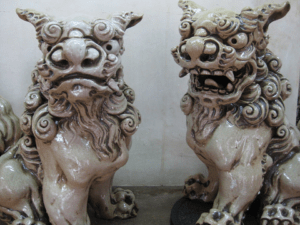The history of Japan’s mythical lion dogs, known as shisa, is rooted in Okinawan folklore and cultural traditions. Shisa is often depicted as a pair of lion-like creatures, with one having an open mouth and the other a closed mouth. These mythical beings are believed to have protective and warding-off powers, serving as guardians against evil spirits and misfortune.
The origin of shisa can be traced back to Chinese guardian lions, known as “shi” or “shishi.” These lion-like statues were introduced to Okinawa through trade and cultural exchanges with China, particularly during the Ming Dynasty (14th to 17th centuries). However, over time, the Okinawans added their own unique touches and interpretations to these guardian lions, resulting in the distinct shisa of today.

Shisa statues are commonly found in pairs, placed at the entrances of houses, businesses, and other buildings. They are believed to protect the occupants and bring good luck. The shisa with an open mouth is called “agari” and is said to ward off evil spirits, while the one with a closed mouth is known as “nagari” and is believed to keep good spirits in.
Legend has it that shisa possess the ability to fly, and they are often depicted with wings. They are also known for their fierce and intimidating appearance, with sharp teeth and bulging eyes. The statues are typically made from stone, clay, or other materials, and their elaborate craftsmanship showcases the artistic traditions of Okinawa.
Shisa has become an iconic symbol of Okinawa and is deeply embedded in its culture. They are not only found as statues but are also incorporated into various forms of art, crafts, and souvenirs. The shisa dance, known as “Shiimii,” is a traditional Okinawan performance that involves dancers wearing shisa masks and costumes, depicting the playful and spirited nature of these mythical creatures.
Today, shisa continues to be revered and celebrated as an important cultural symbol in Okinawa and is cherished by both locals and visitors alike.
Thanks for reading
Gert
